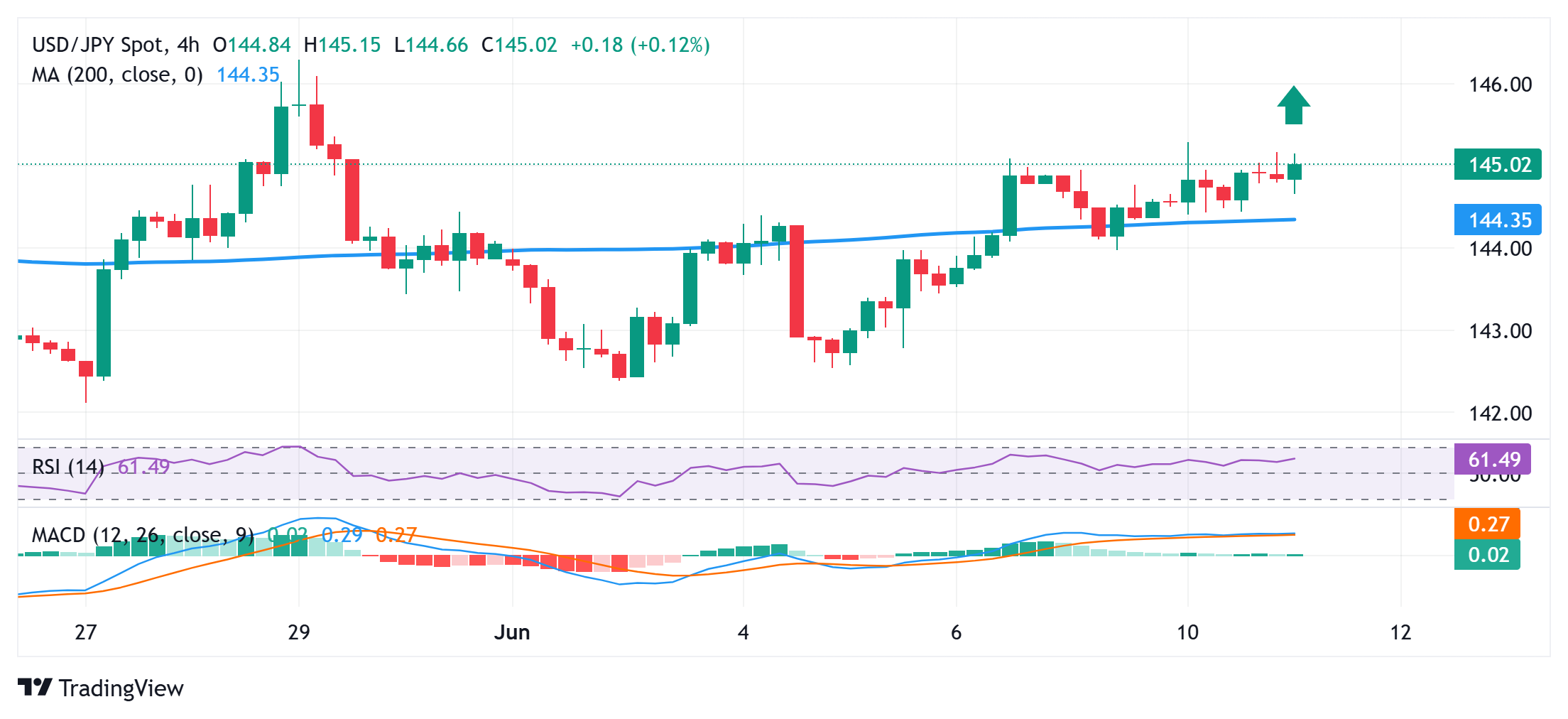- The Japanese Yen struggles to lure buyers as trade optimism undermines safe-haven assets.
- A modest USD uptick lends additional support to USD/JPY, though the upside seems capped.
- The divergent BoJ-Fed policy expectations might continue to act as a headwind for the pair.
The Japanese Yen (JPY) remains close to a nearly two-week low touched against its American counterpart the previous day, though any further decline seems elusive. The latest optimism over a positive outcome from US-China trade talks is seen as a key factor undermining the traditional safe-haven status of the JPY. Adding to this, a modest US Dollar (USD) uptick lifts the USD/JPY pair back above the 145.00 psychological mark during the Asian session on Wednesday.
However, a combination of factors should help limit deeper JPY losses. A federal appeals court ruled that US President Donald Trump’s tariffs can remain in effect while legal appeals continue. This adds to a layer of uncertainty in the markets, which, along with bets that the Bank of Japan (BoJ) will continue raising interest rates, should act as a tailwind for the JPY. Moreover, dovish Federal Reserve (Fed) expectations should cap the Greenback and the USD/JPY pair.
Japanese Yen bulls remain on the defensive despite hawkish BoJ expectations
- Investors turned cautious after a federal appeals court ruled that US President Donald Trump’s “Liberation Day” tariffs on most trading partners could remain in effect while it reviewed a lower court decision to block them. The court, however, is yet to rule on whether the tariffs are permissible under an emergency economic powers act that Trump cited to justify them.
- Data released last week showed that Japan’s economy contracted less than initially estimated during the first quarter. Adding to this, signs of broadening inflation in Japan back the case for further policy normalization by the Bank of Japan. This continues to act as a tailwind for the Japanese Yen, though the optimism over US-China trade talks keeps bulls on the defensive.
- China’s Vice Commerce Minister Li Chenggang told reporters that the Chinese and the US negotiators have agreed on a framework for trade after two days of talks in London. US Commerce Secretary Howard Lutnick said that the framework was the first step to eliminate the negativity, and the implementation plan should result in the resolution of rare earth and magnet issues.
- The optimism stemming from the positive outcome of the crucial US-China trade talks remains supportive of a generally upbeat tone in the equity markets. It undermines the safe-haven status of the JPY. Moreover, signs of easing tensions between the world’s two largest economies assist the US Dollar to attract some buyers and further act as a tailwind for the USD/JPY pair.
- Traders pared their bets that the Federal Reserve will cut interest rates in the next few months following the release of the US Nonfarm Payrolls (NFP) report on Friday, which pointed to a resilient labor market. Traders, however, are still pricing in around 0.45% of easing by the year-end, marking a significant divergence in comparison to hawkish BoJ expectations.
- Traders now look forward to the release of the US Consumer Price Index (CPI), which is forecast to show a pickup that may reinforce the Fed’s wait-and-see stance toward further easing. Nevertheless, the crucial data will be scrutinized for cues about the Fed’s rate-cut path, which, in turn, will influence the USD price dynamics and provide a fresh impetus.
USD/JPY seems poised to climb further while above the 200-period SMA on H4

From a technical perspective, acceptance above the 100-period Simple Moving Average (SMA) and positive oscillators on daily/hourly charts favor the USD/JPY bulls. However, repeated failures to build on momentum beyond the 145.00 psychological mark make it prudent to wait for some follow-through buying beyond the 145.30 area, or a two-week top touched on Tuesday, before positioning for further gains. Spot prices might then surpass the 145.60-145.65 intermediate hurdle and aim to reclaim the 146.00 round figure before climbing further towards the 146.25-146.30 region, or May 29 swing high.
On the flip side, the 200-period SMA on the 4-hour chart, currently pegged near the 144.30 area, might now protect the immediate downside ahead of the 144.00 mark. A convincing break below the latter will negate the positive outlook and shift the near-term bias in favor of the USD/JPY bears. The subsequent decline could drag spot prices down to the 143.60-143.50 region en route to sub-143.00 levels.
US-China Trade War FAQs
Generally speaking, a trade war is an economic conflict between two or more countries due to extreme protectionism on one end. It implies the creation of trade barriers, such as tariffs, which result in counter-barriers, escalating import costs, and hence the cost of living.
An economic conflict between the United States (US) and China began early in 2018, when President Donald Trump set trade barriers on China, claiming unfair commercial practices and intellectual property theft from the Asian giant. China took retaliatory action, imposing tariffs on multiple US goods, such as automobiles and soybeans. Tensions escalated until the two countries signed the US-China Phase One trade deal in January 2020. The agreement required structural reforms and other changes to China’s economic and trade regime and pretended to restore stability and trust between the two nations. However, the Coronavirus pandemic took the focus out of the conflict. Yet, it is worth mentioning that President Joe Biden, who took office after Trump, kept tariffs in place and even added some additional levies.
The return of Donald Trump to the White House as the 47th US President has sparked a fresh wave of tensions between the two countries. During the 2024 election campaign, Trump pledged to impose 60% tariffs on China once he returned to office, which he did on January 20, 2025. With Trump back, the US-China trade war is meant to resume where it was left, with tit-for-tat policies affecting the global economic landscape amid disruptions in global supply chains, resulting in a reduction in spending, particularly investment, and directly feeding into the Consumer Price Index inflation.

